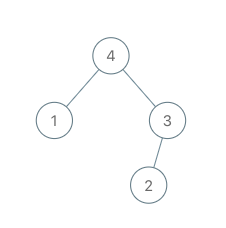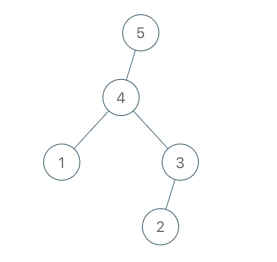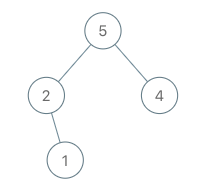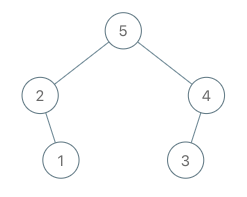最大树定义:一个树,其中每个节点的值都大于其子树中的任何其他值。
给出最大树的根节点 root。
就像之前的问题那样,给定的树是从列表 A(root = Construct(A))递归地使用下述 Construct(A) 例程构造的:
- 如果
A为空,返回null - 否则,令
A[i]作为 A 的最大元素。创建一个值为A[i]的根节点root root的左子树将被构建为Construct([A[0], A[1], ..., A[i-1]])root的右子树将被构建为Construct([A[i+1], A[i+2], ..., A[A.length - 1]])- 返回
root
请注意,我们没有直接给定 A,只有一个根节点 root = Construct(A).
假设 B 是 A 的副本,并在末尾附加值 val。题目数据保证 B 中的值是不同的。
返回 Construct(B)。
示例 1:
输入:root = [4,1,3,null,null,2], val = 5 输出:[5,4,null,1,3,null,null,2] 解释:A = [1,4,2,3], B = [1,4,2,3,5]
输入:root = [5,2,4,null,1], val = 3 输出:[5,2,4,null,1,null,3] 解释:A = [2,1,5,4], B = [2,1,5,4,3]
输入:root = [5,2,3,null,1], val = 4 输出:[5,2,4,null,1,3] 解释:A = [2,1,5,3], B = [2,1,5,3,4]
提示:
1 <= B.length <= 100
已知最大树 A,插入一个值 val 后,返回插入后的树。
如果 val 是最大数,那么将 val 作为新的根节点,root 作为新的根节点的左子树。
如果 val 不是最大数,由于 val 是在最后追加的数,那么一定是在 root 的右边,所以将 val 作为新节点插入 root 的右子树即可。
# Definition for a binary tree node.
# class TreeNode:
# def __init__(self, val=0, left=None, right=None):
# self.val = val
# self.left = left
# self.right = right
class Solution:
def insertIntoMaxTree(self, root: TreeNode, val: int) -> TreeNode:
if root is None or root.val < val:
return TreeNode(val, root, None)
root.right = self.insertIntoMaxTree(root.right, val)
return root/**
* Definition for a binary tree node.
* public class TreeNode {
* int val;
* TreeNode left;
* TreeNode right;
* TreeNode() {}
* TreeNode(int val) { this.val = val; }
* TreeNode(int val, TreeNode left, TreeNode right) {
* this.val = val;
* this.left = left;
* this.right = right;
* }
* }
*/
class Solution {
public TreeNode insertIntoMaxTree(TreeNode root, int val) {
if (root == null || root.val < val) {
return new TreeNode(val, root, null);
}
root.right = insertIntoMaxTree(root.right, val);
return root;
}
}/**
* Definition for a binary tree node.
* class TreeNode {
* val: number
* left: TreeNode | null
* right: TreeNode | null
* constructor(val?: number, left?: TreeNode | null, right?: TreeNode | null) {
* this.val = (val===undefined ? 0 : val)
* this.left = (left===undefined ? null : left)
* this.right = (right===undefined ? null : right)
* }
* }
*/
function insertIntoMaxTree(root: TreeNode | null, val: number): TreeNode | null {
if (root == null || val > root.val) {
return new TreeNode(val, root);
}
root.right = insertIntoMaxTree(root.right, val);
return root;
};/**
* Definition for a binary tree node.
* struct TreeNode {
* int val;
* TreeNode *left;
* TreeNode *right;
* TreeNode() : val(0), left(nullptr), right(nullptr) {}
* TreeNode(int x) : val(x), left(nullptr), right(nullptr) {}
* TreeNode(int x, TreeNode *left, TreeNode *right) : val(x), left(left), right(right) {}
* };
*/
class Solution {
public:
TreeNode* insertIntoMaxTree(TreeNode* root, int val) {
if (root == nullptr || root->val < val) {
return new TreeNode(val, root, nullptr);
}
root->right = insertIntoMaxTree(root->right, val);
return root;
}
};/**
* Definition for a binary tree node.
* type TreeNode struct {
* Val int
* Left *TreeNode
* Right *TreeNode
* }
*/
func insertIntoMaxTree(root *TreeNode, val int) *TreeNode {
if root == nil || root.Val < val {
return &TreeNode{
Val: val,
Left: root,
Right: nil,
}
}
root.Right = insertIntoMaxTree(root.Right, val)
return root
}





